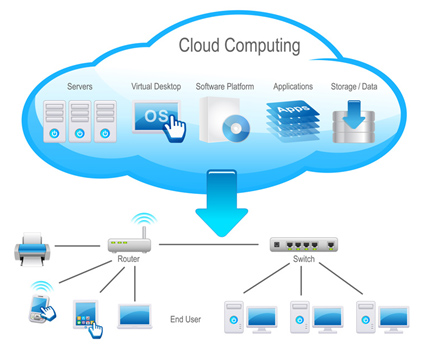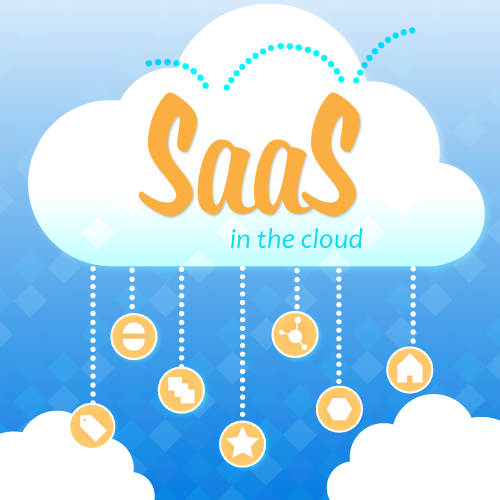 Firstly, what does this term mean? The word “cloud” relates to the cloud computing representation used historically to illustrate the telephone network and more recently to represent the Internet in computer diagrams. So, it’s basically a metaphor for the Internet.
Firstly, what does this term mean? The word “cloud” relates to the cloud computing representation used historically to illustrate the telephone network and more recently to represent the Internet in computer diagrams. So, it’s basically a metaphor for the Internet.
Overall, cloud computing is a rather an ambiguous term that takes in a number of technologies that all deliver computing as a service instead of a product.
Investopedia’s definition makes reference to ‘a cloud computing structure allowing access to information, provided an electronic device has access to the web’
If you have used Web e-mail systems such as Hotmail, Yahoo! Mail or Gmail, then you have used a form of cloud computing. Here the user logs into their web e-mail account remotely via a browser rather than running an e-mail program locally on their computer. The mail software and storage resides on the service provider’s computer cloud and does not exist on the user’s machine. This is a good example of cloud computing application as shared resources such as software and information are delivered as a utility via a network, usually the Internet. This, in turn, is analogous to electricity delivered as a metered service over the grid. Users machines can be computers or other devices such as smartphones, dumb terminals etc.
This brings up 2 major terms required to fully appreciate the world of “the cloud”, firstly utility computing which relates to the mechanics of delivering resources typically computation and storage are delivered as a metered service; again analogous to other utilities such as electricity. The second of these terms is autonomic computing which describes how systems are self-managing; the term self-healing has been applied but great care needs to be taken with that term!
Cloud based applications are accessed through a web browser or lightweight desktop/mobile app with the data and business software being held on servers at a remote location, usually a data center. Cloud application providers (ASPs = application Service Providers) aim to deliver the same or better service and performance versus applications running on end-user computers locally.
Cloud computing applications continue to be adopted quickly with uptake driven by the availability of high bandwidth capacity networks (importantly down to the end user/client level by high bandwidth broadband or other internet connections), low cost high availability disk storage, inexpensive computers plus large scale adoption of both visualization and IT architecture designed for the service model.
There are three basic models of cloud computing:
IaaS is simplest and each higher model builds on features of the lower models.
The most basic cloud service model; cloud providers offer computers as either physical or virtual machines along with access to networks, storage, firewalls and load balancers. Under IaaS these are delivered on demand from large pools installed in data centres with local area networks and IP addresses being part of the offering. For wide area connectivity, the Internet or dedicated virtual private networks are configured and used.
Cloud users; here defined as those who wish to deploy the application rather than necessarily use it, install operating system images on the machines plus their application software to deploy their applications. Under IaaS, said cloud user is responsible for patching and maintaining the OS plus application software. IaaS services are usually billed on a utility basis, so cost reflects resources allocated and consumed.
Platform as a Service (PaaS) model, the cloud provider typically delivers a computing platform consisting of OS, database, and web server. This enables application developers to run their software solutions on this cloud platform without needing to buy or manage the underlying hardware and software, so eliminating cost and complexity. In some PaaS offerings, computing and storage resources automatically scale to match application demand eliminating complexity further as the cloud user does not have to allocate resources manually.
Under the Software as a Service (SaaS) model cloud providers install and operate application software in their cloud with users accessing the software using cloud clients. A significant benefit is that maintenance and support are very much simplified as users do not manage the cloud infrastructure or the platform running the application and do not need to install or run the application on their own computers. Another major advantage of such a cloud application lies in its elasticity achieved by cloning tasks on to multiple virtual machines as demand requires it. Load balancers distribute this work over the virtual machines and the whole process is transparent to the user who sees simply a single access point. Cloud applications may be multi-tenant, so any machine serves more than one cloud user organization. This illustrates another major advantage of cloud computing as is it can quickly accommodate large numbers of new users or users can be quickly dropped as usage demands which again is reflected in the pay per user model. These types of cloud based application software are commonly referred to as desktop as a service, business process as a service, Test Environment as a Service or communication as a service.
The pricing model for SaaS applications is typically either a monthly or yearly flat fee per user. If you are looking for a cloud service provider, browse qwertycstaging.wpengine.com.
 For an application to be a true cloud application it must be dynamically scalable and one of the biggest current problems associated with cloud computing is “cloud washing” (also spelled cloudwashing).
For an application to be a true cloud application it must be dynamically scalable and one of the biggest current problems associated with cloud computing is “cloud washing” (also spelled cloudwashing).
Cloud washing is the purposeful and sometimes deceptive attempt by a vendor to re-brand an old product or service by associating the buzzword “cloud” with it.
So, it’s a deliberate attempt to sell an existing product, albeit delivered from a server in a data center, but adding the label “cloud” to deceive potential buyers into buying it when the fundamental product does not meet the criteria to a true cloud application. Cloud washing is comparable to green washing where a product is described as environmentally friendly on specious grounds. In both cases the term washing implies a thin daubing of paint in the form of a marketing message to cover cracks bringing a false and deceptive new appearance to the product.
Source: http://searchcrm.techtarget.com/definition/greenwashing
Relying on the internet as a means of delivery does not justify the label cloud and a true cloud service requires:
It is fair to say that true scalability is difficult to achieve for a couple of reasons.
Firstly it must be designed in to the application from the outset and cannot be an afterthought. Many algorithms that perform apparently well, fall apart when placed under the load imposed by large numbers of requests, large numbers of nodes and large data sets.
Secondly there is the issue presented by an inability to preserve a completely heterogeneous architecture as the hardware estate (the cloud itself) expands. Essentially this is driven by obsolescence of hardware, so as new system nodes are added, they are not identical to those already in use; indeed they are typically more powerful and have larger storage capacity etc. This means that new modes perform more quickly and store more data than older ones meaning the algorithms must be able to deal with nodes that perform at varying speeds.
In summary then, it is not enough to shove an existing application on to a server in a data center and sell it as a cloud application; the application must be written and engineered to achieve true scalability from the outset.
